This news release originally appeared on the NY Sea Grant Website on March 25, 2022.
A handful of new Sea Grant specialists — in both New York and Connecticut — help expand Long Island Sound Study efforts throughout the Sound’s basin
— By Chris Gonzales, Freelance Science Writer, New York Sea Grant
Contacts:
Robert Burg, Communications Coordinator, Long Island Sound Study,
E: rburg@longislandsoundstudy.net
Paul C. Focazio, Communications Manager, New York Sea Grant,
E: Paul.Focazio@stonybrook.edu, P: 631-632-6910
Kathy Bunting-Howarth, NYSG’s Associate Director,
E: keb264@cornell.edu, P: 607-255-2832
Stony Brook, NY, March 25, 2022 — What is “resilience” and what does it mean for your community?
New York Sea Grant (NYSG) has announced the hiring of a team of new professionals dedicated to protecting the communities, economy, and environment of Long Island Sound. This new work stems from a partnership with the Long Island Sound Study (LISS). Federal LISS funding supports the new team members.
Three Sustainable and Resilient Communities (SRC) extension professionals have begun working to strengthen the network of sustainable and resilient communities along the Long Island Sound in Westchester, Nassau, and Suffolk Counties. Additionally, a new outreach coordinator has been hired to work in Long Island Sound’s Western Basin, covering New York City and Westchester County, supplementing an existing position in Stony Brook.
The Plan for Resilience in the Sound
The Long Island Sound Study focuses on four main themes: Clean Waters and Healthy Watersheds, Thriving Habitats and Abundant Wildlife, Sustainable and Resilient Communities, and Sound Science and Inclusive Management. These four new positions in New York, plus two new SRC extension professionals in Connecticut, mark the growth of the program in both states, on either side of the Sound. This team represents a commitment to prepare for and mitigate the effects of environmental and economic challenges posed by the effects of climate change and to expand community engagement along the Long Island Sound.
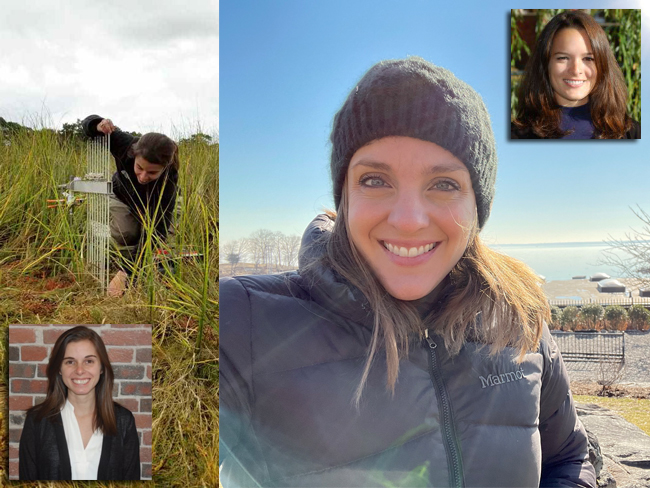
(l-r) Elizabeth Hornstein (also inset, lower left) conducts surface elevation table readings of a salt marsh. This helps assess if the marsh is keeping pace with sea level rise; Sara Powell snapped this selfie during a site visit to Manor Park, overlooking Long Island Sound in Larchmont, NY; Sarah Schaefer-Brown (inset, upper right).
Meet the SRC Extension Professionals
Sara Powell, Westchester County, based at Cornell Cooperative Extension of Westchester County, Elmsford, New York
Powell has more than a decade of experience working as a science communicator with expertise in partnership building, environmental planning, and urban water resource management. She has a master’s degree in environmental health sciences from the University of South Carolina. Prior to joining NYSG, she most recently worked in New York City as the Ambassador for the Bronx & Harlem Rivers Urban Waters Federal Partnership.
Elizabeth Hornstein, Suffolk County, based at Stony Brook University
Hornstein has a master’s degree in marine science from Stony Brook University and over ten years of experience working in the marine and environmental conservation fields. Before coming to NYSG, she was state coordinator for the Peconic Estuary Partnership (PEP), collaborating with government organizations, academic institutions, environmental groups, and community members to protect and restore the Peconic Estuary.
Sarah Schaefer-Brown, Nassau County, based at Cornell Cooperative Extension of Nassau County, East Meadow, New York
Schaefer-Brown has years of experience leading a range of projects with a focus on water quality improvement, habitat restoration, climate change planning, and community outreach. Prior to her role at NYSG she was the program coordinator for the Peconic Estuary Partnership, where she worked to facilitate ecosystem-based management of the Peconic Estuary watershed. She holds a master’s degree in marine conservation and policy from Stony Brook University.
What the SRC Extension Professionals Are Doing
The three SRC extension professionals are working with their respective coastal communities to advance the Sustainable and Resilient Communities goals of the Long Island Sound Study. The SRC extension professionals will be focusing on providing support, training, and tools for the entire Long Island Sound coastal community with the goal of building a coordinated regional response to current and future climate change impacts, empowering better trained and informed community decision makers, and increasing implementation of resilience projects. Specific projects might include using natural features, like oyster castles or native salt marsh plants, to enhance protection of the shoreline, or conducting outreach with coastal residents about actions that can make them more resilient in the face of severe weather and more frequent flooding.
This team is part of a larger initiative led by both New York and Connecticut Sea Grants and guided by a five-year plan that increases the capacity of both Sea Grant programs to create a sustainable and resilient regional framework to strengthen the social, environmental, and economic well-being of Long Island Sound communities. The two programs are working together to respond to infrastructure and environmental vulnerabilities brought about by our changing climate.
Two additional SRC extension professionals have been hired in Connecticut via Connecticut Sea Grant at UConn. They are Deborah Visco Abibou (based out of the New Haven County Extension Center in North Haven, primarily serving western Connecticut) and Alicia Tyson (working out of the UConn Avery Point campus in Groton, primarily serving eastern Connecticut.)
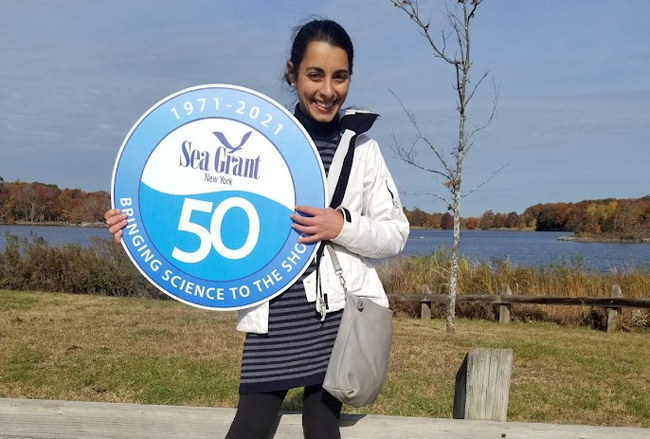
NYSG’s Long Island Sound Study Outreach Coordinator Lillit Genovesiat at the Edith G. Read Wildlife Sanctuary in Rye, NY. Credit: Ludmilar Mesidor / Long Island Sound Study.
Long Island Sound Outreach Coordinator
Lillit “Lilli” Genovesi is the new Long Island Sound Study outreach coordinator for New York City and Westchester County. Based in the New York City Department of Environmental Protection (DEP) office in Queens, Lilli is working alongside the Stony Brook University–based outreach coordinator, Jimena Perez-Viscasillas, to engage communities in LISS programs, activities, and resources. Perez-Viscasillas has been with NYSG since 2019.
Before joining NYSG, Genovesi worked with Trout Unlimited, where she managed the statewide Trout in the Classroom program alongside the New York City Department of Environmental Protection and New York State Department of Environmental Conservation. Lilli holds a master’s degree in Environmental Science from the City University of New York and an undergraduate degree in Marine Biology from UCLA.
The outreach coordinators are tasked with addressing climate change impacts on the Sound with focus on environmental justice—practices that ensure that all people enjoy the same degree of protection from environmental and health hazards, and are given equal access to the decision-making that affects the environments in which they live, learn, and work.1
“Addressing climate-change impacts as well as water-quality and habitat challenges while ensuring that all people, especially communities suffering disproportionately from environmental threats, are engaged in the solutions requires professionals in the field, building relationships and working through partnerships,” said NYSG’s Associate Director Kathy Bunting-Howarth. “These new positions will enhance the LISS and NYSG’s ability to learn what our communities need and provide them with assistance tailored to those needs.”
References
1https://www.epa.gov/environmentaljustice Retrieved February 8, 2022.
More Info: Long Island Sound Study
Long Island Sound is one of the 28 nationally designated estuaries under the National Estuary Program (NEP), which was established by Congress in 1987 to improve the quality of Long Island Sound and other places where rivers meet the sea.
The Long Island Sound Study is a cooperative effort involving researchers, regulators, user groups and other concerned organizations and individuals, and is led by the Environmental Protection Agency and the states of New York and Connecticut.
In recent years, LISS has experienced a period of rapid expansion attributed to the increased federal funding for the program, and to implement actions, objectives, and goals established under a Comprehensive Conservation and Management Plan. The increase is grounded in the CCMP’s four overarching themes: Clean Waters and Healthy Watersheds, Thriving Habitats and Abundant Wildlife, Sustainable and Resilient Communities, and Sound Science and Inclusive Management. Resilience to climate change, long-term sustainability, and environmental justice, are principles that connect to all four of the themes.
For more on what you can do to make a difference, click over to the “Get Involved” or “Stewardship” sections of the Long Island Sound Study’s website. News on the Long Island Sound Study can also be found in New York Sea Grant’s related archives.
If you would like to receive Long Island Sound Study’s newsletter, please visit their site’s homepage and sign up for the “e-news/print newsletter” under the “Stay Connected” box.
More Info: New York Sea Grant
New York Sea Grant (NYSG), a cooperative program of Cornell University and the State University of New York (SUNY), is one of 34 university-based programs under the National Oceanic and Atmospheric Administration’s National Sea Grant College Program.
Since 1971, NYSG has represented a statewide network of integrated research, education and extension services promoting coastal community economic vitality, environmental sustainability and citizen awareness and understanding about the State’s marine and Great Lakes resources.
Through NYSG’s efforts, the combined talents of university scientists and extension specialists help develop and transfer science-based information to many coastal user groups—businesses and industries, federal, state and local government decision-makers and agency managers, educators, the media and the interested public.
This article was originally published on the CT Sea Grant website on Dec. 7, 2021
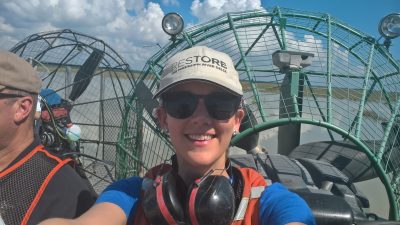
By Judy Benson
If experience really is the best teacher, Deborah Abibou and Alicia Tyson have been to some of the prime places to learn about community resilience work.
Those include locations facing some of the biggest challenges from sea level rise, intensifying storms and other climate change effects: Puerto Rico, Louisiana, Peru and Costa Rica. Now, they’re ready to apply the knowledge they’ve gained toward helping Connecticut’s coastal communities with those same challenges. It’s a task they’re taking on with enthusiasm.
“I’m excited to get to work,” said Tyson.
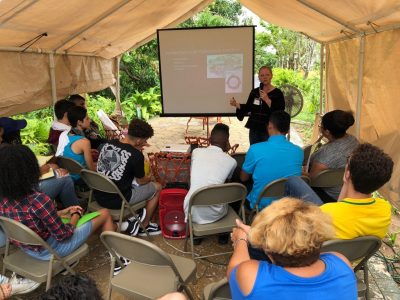
“I’m really looking forward to diving in,” said Abibou.
The two joined the Connecticut Sea Grant staff on Nov. 19, filling new positions as sustainable and resilient community extension educators. Abibou will be based out of the New Haven County Extension Center in North Haven to focus mainly on coastal communities in the western half of the state. Tyson will work out of the UConn Avery Point campus in Groton to focus on the eastern half.
CT Sea Grant Director Sylvain De Guise said the hiring of Tyson and Abibou is part of a larger initiative with New York Sea Grant that increases the capacity of both programs to better serve coastal communities dealing with more frequent flooding of roads and bridges, wetland loss, erosion and other problems worsening as climate change effects intensify. Under the umbrella of a new Long Island Sound Study working group led by both Sea Grant programs, a five-year work plan was created to map out the best ways to tackle these common challenges. To implement the plan, the programs obtained federal funding to support the creation of three new extension positions in New York and two in Connecticut.
“We all know it is a significant challenge for coastal communities to become resilient to the effects of climate change,” De Guise said. “We now have more people on the ground working at the interface of the built environment, the needs of people and sustainable ecosystems on resilience projects.”
N.Y. Sea Grant Director Rebecca Shuford said the three new staff based in her state will coordinate with their counterparts in Connecticut to ensure their individual work plans complement one another in helping fulfill the goals of the overall initiative. She envisions all five will focus on building relationships with communities in their respective areas to ensure they all have the plans and tools needed to meet climate change challenges. The new staff at NY Sea Grant are: Elizabeth Hornstein, based in Suffolk County; Sarah Schaefer-Brown, based in Nassau County; and Sara Powell, based in Westchester County.
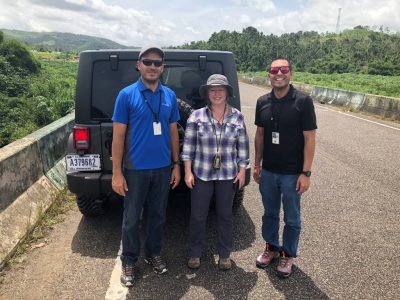
“I see these positions as being really pivotal to achieving the goals and objectives of the work plan,” Shuford said. “There is also an environmental justice priority to work with all communities in filling gaps to ensure there’s appropriate resources available.”
Abibou, 37, spent her early academic and professional career doing avian biology and conservation work, including a stint doing research in Costa Rica while pursuing a doctorate at Tulane University in New Orleans. Following this, she focused on the intersection of habitat restoration and the built environment. New Orleans’ location provided the ideal field school for understanding how the needs of both nature and people can best be met amid the shifting conditions of climate change.
“In Louisiana, the land loss from sea level rise is accelerating, but it’s also a center for innovation about how to design projects for climate resilience,” she said.
Many of the projects she worked on there directly involved communities in tree and marsh grass planting, oyster shell recycling, oyster cultch planting and dune restoration, among other efforts. Similarly, she hopes to incorporate communities in projects in her new home state in Connecticut.
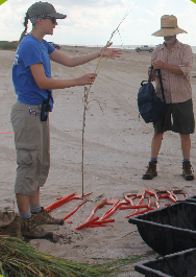
“I want to work on the most pressing problems in my own back yard,” said Abibou, who relocated to Hamden, CT, last spring when her husband accepted a position at Yale University.
For Tyson, 45, working at the intersection of the human and natural environment followed nearly a decade in broadcast journalism, technical writing and website development. As a master’s degree student, she used geographic information systems software to model landslide susceptibility and risk perception in the Machu Picchu Pueblo community in Peru.
She then focused on flood modeling and data projects for federal agencies and taught geology at a community college before starting a doctoral program. Fluent in Spanish, she traveled to Puerto Rico after Hurricane Maria as part of her doctoral work to assess the array of risks and challenges facing communities there. That included leading efforts to engage residents in assessing their ability to adapt and recover from flooding, landslides and other extreme events. She expects to complete her doctorate this spring.
“I’ve had the opportunity to work with marginalized communities on issues of environmental justice and resilience,” she said. “It’s a passion of mine.”
Tyson’s most recent position was at Progressive Partnering, a geospatial software development company based in Nashville. As a volunteer, she participated in the Urban-Reginal Information Systems Association’s GISCorps in mapping the impact of Hurricane Ida and other extreme weather events. Through her various experiences, she said, she has gained perhaps the best possible preparation for her new job at CT Sea Grant.
“It’s amazing how life happens,” said Tyson, who plans to relocate from Nashville to southeastern Connecticut in the coming weeks. “This position is truly the culmination of everything I’ve been working on for the past 11 years.”
De Guise noted that the unique skills Tyson and Abibou bring, together with those of their NY Sea Grant colleagues, position the two programs to play a leading role in helping the two states respond proactively to infrastructure and environmental vulnerabilities being exposed by the changing climate. Communities can tap into a growing pool of resources available for these projects—including $1 trillion in the bipartisan federal infrastructure bill signed into law last month, and another $2 trillion in the Build Back Better bill pending in the Senate. But they will need the expertise these five staff can provide to help make that happen, he said.
“There’s a number of programs that recognize the urgency of the need, and have resources, but it needs to get into the right hands,” he said.
Click here for information about how to reach Deb Abibou and Alicia Tyson.
Judy Benson is the communications coordinator for Connecticut Sea Grant.

The Long Island Sound Futures Fund (LISFF) is seeking proposals to restore the health and living resources of Long Island Sound with funding of approximately $10 million for awards in 2022. The program is managed by National Fish and Wildlife Foundation (NFWF) in collaboration with EPA and the Long Island Sound Study (LISS). Major funding for the program is from EPA through the LISS with additional funding from the US Fish and Wildlife Service and the Avangrid Foundation. Learn more, and read the Request for Proposals, on the NFWF website. The deadline to apply is May 19, 2022.
Visit the Futures Fund section of the Long Island Sound Study website to learn about past projects funded since 2005.
 The National Fish and Wildlife Foundation will be soliciting Requests for Proposals for the 2022 Long Island Sound Futures Fund in March. There is potential funding of $10 million or more* for Environmental Grants in the Long Island Sound Watershed (CT, NY, MA NH, VT). Grant range $50k – $1.5m. Lower match in 2022! Get Started Now! Share a Project Idea! Want Feedback? Fill out this form and send to Erin.Lewis@nfwf.org! The deadline to submit project ideas is April 22, 2022. Project Types & Geographies? Habitat restoration planning or implementation grants for projects in the Long Island Sound Study coastal zone of CT & NY… Resilience, education, water quality and fish passage grants for projects in the Long Island Sound Study boundary in CT and NY… Nitrogen prevention or reduction planning or implementation grants for projects in the Long Island Sound Study boundary in NY, CT, MA, NH, VT! Tell us who you are! Send Erin.Lewis@nfwf.org names and emails to receive notifications about grants & upcoming applicant webinars. Sponsors: The National Fish and Wildlife Foundation, EPA, US Fish and Wildlife Service, and the Long Island Sound Study. * The availability of federal funds estimated in this solicitation is contingent upon the federal appropriations process. Funding decisions will be made based on level of funding and timing of when it is received by NFWF. |
Read the Winter 2021-2022 issue of Sound Matters, the newsletter of the Long Island Sound Study.
Fishing is a fun activity for the Sound’s anglers, with a bonus that they can bring home a healthy, high protein food. But some fish can contain toxic contaminants such as mercury that is harmful to both fish and humans. Large fish can particularly be exposed to high levels of mercury through a process call Biomagnification or Bioaccumulation, which is why health departments issue advisories to limit consumption of some fish.
From the smokestacks of power plants to the discharges from wastewater treatment plants, and other places, mercury in the form of the compound methylmercury exists in the enviroment, and it can settle to the seafloor and be taken up by tiny organisms that live or feed on bottom sediments.
From there mercury or other toxic contaminants that settle on the seafloor poses a threat to the ecosystem. According to NOAA’s Ocean Explorer website:
… these compounds aren’t digested, they accumulate within the animals that ingest them, and become more and more concentrated as they pass along the food chain as animals eat and then are eaten in turn. This is biomagnification, and it means that higher-level predators-fish, birds, and marine mammals-build up greater and more dangerous amounts of toxic materials than animals lower on the food chain.
Human exposure to methylmercury occurs mostly from consuming fish and shellfish and “almost all people have at least small amounts of methylmercury in their bodies, reflecting the widespread presence of methylmercury in the environment,” according to EPA’s Health Effects of Exposures to Mercury. For most people, blood mercury levels are below levels associated with possible health effects, but the EPA website includes this warning: “Methylmercury … is a powerful neurotoxin, and people exposed to high levels may experience adverse health effects. If you are concerned about your exposure to methylmercury, you should consult your physician.”
Facts about Mercury and Long Island Sound
- With the decline in industry around Long Island Sound and tighter regulations, concentrations of mercury in Long Island Sound have declined, but are still higher than the pre-industrial period of the 19th century. (source: https://longislandsoundstudy.net/wp-content/uploads/2017/11/heavy-metals-in-sediment.pdf)
- Mercury deposited in marshes can be harmful to the reproduction of tidal marsh songbirds, according to new research conducted by a team of scientists in the Northeast who belong to the Saltmarsh Habitat and Avian Research Program. Read an abstract from the scientific journal, Ecotoxicology.
- In the 2000s the Long Island Sound Study Research Grant program provided grants for research on mercury and other toxic contaminants. Information on these research projects are in the Long Island Sound Research Grant Program web pages:
- Chemical Residues in Fish and Lobster in Long Island Sound: A Bi-State Update (see description in 2008 research grant page)
- Environmental Change in Long Island Sound over the Last 400 Years (see description in 2000 research grant page)
The Mad Hatter Mercury Mystery
In 2002, Peg Van Patten, who was then the Communications Director for Connecticut Sea Grant, profiled Dr. Johan “Joop” Varekamp in Wrack Lines magazine on his research connecting mercury contamination in the Sound with an industrial city’s hat making past. Varekamp, who was then a professor in the Earth and Environmental Sciences Department at Wesleyan University, was able to trace through sediment core samples that the source of mercury deposits found in the Housatonic River at the mouth of Long Island Sound was from Danbury, a city located off the banks of the Still River, an upstream tributary of the Housatonic. In the 19th century and 20th centuries Danbury was known as the Hat City where fur hats were manufactured using mercury to toughen the fur hat fibers. Varekamp also wrote about the legacy contaminant in the fall 2012 issue of Long Island Sound Study’s Sound Update newsletter (see page 3).
Inside the Long Island Sound Food Web
NYSG/LISS Partnership spans over 30 years
Contacts:
Lillit (Lilli) Genovesi, Long Island Sound Outreach Coordinator, NYC, E: Lillit.Genovesi@Cornell.edu
Robert Burg, Communications Coordinator, Long Island Sound Study, E: rburg@longislandsoundstudy.net
Paul C. Focazio, Communications Manager, New York Sea Grant, E: Paul.Focazio@stonybrook.edu
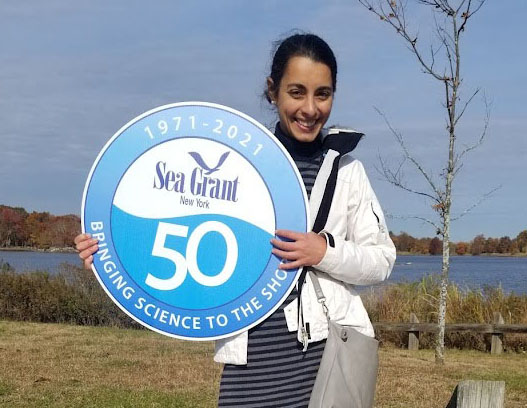
QUEENS, NY, Dec. 7, 2021 — New York Sea Grant (NYSG) has provided outreach and education on coastal issues in New York City and Westchester for decades, but never with a position fully dedicated in those areas to Long Island Sound. That changed last month, driven by the need to address resiliency due to the impacts from climate change and expand community involvement and education. Through the Long Island Sound Study (LISS) partnership, NYSG has expanded its outreach programs by hiring Lillit (Lilli) Genovesi as Outreach Coordinator for communities along Long Island Sound in New York City and Westchester County. This complements a LISS Outreach position based in Long Island since the 1980s that focuses more on Nassau and Suffolk Counties.
This new position will be based in Queens and secured as a partnership with the New York City Department of Environmental Protection (DEP).
Besides drawing attention to the efforts to ensure a resilient coastline and ecosystem due to the impacts of climate change in New York City, Westchester, the outreach coordinator also will be focused on two other important LISS principles — long-term sustainability and environmental justice. In addition, Genovesi will engage New Yorkers in LISS activities and efforts, including working with local community groups to develop habitat loss and pollution remediation solutions in the estuary.
“Addressing climate change, environmental justice and stormwater challenges through outreach is of utmost importance in NYC and Westchester county if we are going to support these communities and the health of the Sound,” said Katherine Bunting-Howarth, Associate Director of NYSG and Assistant Director, Cornell Cooperative Extension . “We’re thrilled that Lilli has joined the team and we are confident that she will support and grow the knowledge of residents about the benefits of a healthy Long Island Sound while empowering these communities to improve their local environment”.
“Our goal is to support and empower people in communities all around the Sound with the tools and knowledge to be environmental stewards of Long Island Sound.” said Mark Tedesco, Director of the Environmental Protection Agency’s Long Island Sound Office. “We are proud to partner with NYSG to increase the engagement and knowledge of residents in the far western portions of Long Island Sound.”
“New York City has made substantial investments to improve the health of Long Island Sound and Lilli will be a terrific asset in ensuring that we engage all New Yorkers in the important work still to do, including further improving water quality and restoring the ecology of the Sound,” said DEP Deputy Commissioner for Sustainability Angela Licata. “Over the years Lilli has helped to introduce thousands of New York students to the importance of protecting our drinking water supply and we are excited to continue this partnership, now with a focus on Long Island Sound and ensuring this message reaches all New Yorkers, especially those in underrepresented groups.”
Before joining NYSG, Genovesi spent a combined 13 years with Trout Unlimited (TU), where she managed the statewide Trout in the Classroom program alongside the DEP and New York State Department of Environmental Conservation. Prior to TU, Genovesi lived in Los Angeles and conducted outreach for the Natural History Museum of Los Angeles.
“I am excited to have joined the talented team at LISS and Sea Grant and look forward to serving in this important role that will help all New Yorkers, living in and around the Western basin of the Long Island Sound, appreciate this amazing resource,” said Genovesi. “Working together with our partners, local community groups, and individuals gives us the opportunity to envision a bright future for the people and places along our coasts.”
About LISS
The Long Island Sound Study is a cooperative effort involving researchers, regulators, user groups and other concerned organizations and individuals, and is led by EPA and the states of New York and Connecticut.
In recent years, LISS has experienced a period of rapid expansion attributed to the increased federal funding for the program, and to implement actions, objectives, and goals established under a Comprehensive Conservation and Management Plan. The increase is grounded in the CCMP’s four overarching themes: Clean Waters and Healthy Watersheds, Thriving Habitats and Abundant Wildlife, Sustainable and Resilient Communities, and Sound Science and Inclusive Management. Resilience to climate change, long-term sustainability, and environmental justice, are principles that connect to all four of the themes.
Learn more about the program at www.longislandsoundstudy.net.
About NYSG
New York Sea Grant is a cooperative program of Cornell University and the State University of New York, and one of 34 university-based programs under the National Oceanic and Atmospheric Administration’s National Sea Grant College Program.
Since 1971, New York Sea Grant has promoted coastal vitality, environmental sustainability, and citizen awareness about the state’s marine and Great Lakes resources.
More at www.nyseagrant.org, including links to Facebook, Twitter, Instagram, and YouTube.
Contact Information:
Kristen Peterson, for National Fish and Wildlife Foundation (NFWF), 410-353-3582, kpeterson@thehatchergroup.com
Mikayla Rumph, US EPA Region 1 (New England), 617-918-1016, rumph.mikayla@epa.gov
Stephen McBay, US EPA Region 2, 212-637-3672, McBay.Stephen@epa.gov
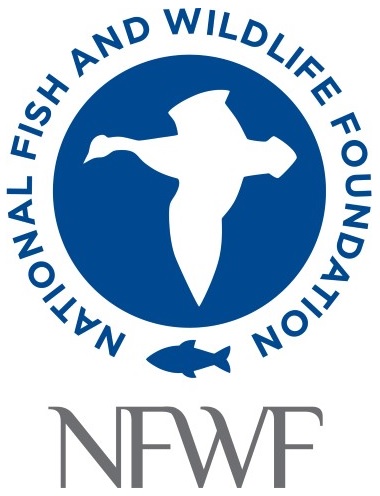
LONG ISLAND SOUND WATERSHED (December 6, 2021) – Today, the US Environmental Protection Agency (EPA), the National Fish and Wildlife Foundation (NFWF), the US Fish and Wildlife Service (FWS), the Connecticut Department of Energy and Environmental Protection (CT DEEP), the New York State Department of Environmental Conservation (NYSDEC), and elected federal officials from New England and New York joined together to announce 39 grants totaling $5.4 million to state and local government, nonprofit organizations and community groups to improve the health and ecosystem of Long Island Sound. The grants are matched by $4.8 million from the grantees themselves, resulting in $10.2 million in combined total funding for conservation projects around the Long Island Sound watershed of Connecticut, New York, and Vermont.
In all, the LISFF 2021 grants will reach more than 290,000 residents through environmental education programs and conservation projects. Water quality improvement projects will treat 353,000 gallons of stormwater annually and install 43,000-square-feet of green infrastructure. The projects will also remove 97,700 pounds of marine debris from the Sound and restore 25 acres of critical habitat for fish and wildlife. Funding for the Long Island Sound Futures Fund grant program comes from the EPA as part of the Long Island Sound Study (LISS), and from the FWS and NFWF.
“Long Island Sound is an essential ecosystem that supports communities, economies and habitats across the region, and we are proud to support local projects that will protect the environment,” said EPA New England Acting Regional Administrator Deborah Szaro. “This year’s recipients showcase diverse and innovative projects that help to protect and restore Long Island Sound.”
“EPA and its partners enthusiastically support New Yorkers’ active engagement and stewardship in protecting the Long Island Sound,” said EPA Region 2 Regional Administrator Lisa F. Garcia. “Focusing on climate change and climate justice are key priorities, and these projects help provide real long-term results, including improving water quality, preventing pollution, protecting and restoring habitat, wildlife and wetlands, as well as educating the public.”
This grant program has a strong history of making tangible improvements to water quality in Long Island Sound. Past projects include community-based efforts to restore habitat, reduce polluted runoff, and engage people in stewardship of the Sound’s lands and waters.
The EPA, the LISS and NFWF were pleased to be joined at the virtual event by Connecticut Senator Richard Blumenthal, Connecticut Senator Chris Murphy and three of the co-chairs of the Long Island Sound Congressional Caucus Representative Joe Courtney (CT), Representative Lee Zeldin (NY) and Representative Thomas Suozzi (NY). To see a list of quotes from federal elected officials about today’s grant announcement please click here.
“One of the greatest environmental challenges facing our nation and its communities is the protection and restoration of highly productive estuaries,” said Jeff Trandahl, Executive Director and CEO of NFWF. “The funding awarded today represents our continued commitment, together with our public and private partners, to restoration efforts that are improving the overall health of Long Island Sound.”
The Long Island Sound Study initiated the LISFF in 2005 through the EPA’s Long Island Sound Office and NFWF. Since its inception, the LISFF invested $32 million in 529 projects. The program has generated an additional $49 million in grantee match, for a total conservation impact of $81 million for regional and local projects. The projects have added 115 river miles for fish passage, restored 805 acres of critical fish and wildlife habitat, treated 201 million gallons of pollution, and educated and engaged over 4 million people in the protection and restoration of the Sound.
“These investments empower local communities to shape their future by conserving healthy and resilient coastal habitats, creating free-flowing rivers and river systems that reduce flooding and increase fish passage, and helping to develop the next generation of environmental leaders,” said Wendi Weber, North Atlantic-Appalachian Regional Director for the US Fish and Wildlife Service. “Funded projects apply nature-based solutions that benefit a wide range of fish and wildlife, such as roseate tern, river herring, shorebirds like American oystercatcher, and the climate-vulnerable saltmarsh sparrow. Equally important, they support public engagement and environmental justice measures that allow Long Island Sound residents to lead positive change in their communities and expand access to nature and its benefits.”
“It is amazing to see the work underway and planned that will preserve and protect the Long Island Sound and the rivers that flow to it for the benefit of all who enjoy and utilize its watershed,” said Katie Dykes, Commissioner, Connecticut Department of Energy and Environmental Protection. “We are honored to celebrate the awarding of over $2.1 million in grants to 19 recipients in Connecticut, which also leverages over $1.9 million in local funding. We are thankful for these federal funds that will improve one of our most-cherished resources and so heartened by the efforts of our partners that have developed projects that will help Connecticut DEEP and US EPA protect and improve the health of Long Island Sound.”
“The Long Island Sound is an economic and environmental treasure, benefiting the region’s natural resources and economy, “said DEC Commissioner Basil Seggos. “An example of the power of collaboration among federal and state agencies and officials, the Long Island Sound Futures Fund helps safeguard the health of the Sound and its ecosystems, as well as coastal communities, by investing in projects to improve water quality, conserve habitats, and promote public awareness. DEC congratulates the awardees announced today and looks forward to the successful implementation of projects to protect the Sound.”
To see a list of all grants made this year please click here.
BACKGROUND
Long Island Sound is an estuary that provides economic and recreational benefits to millions of people while also providing habitat for more than 1,200 invertebrates, 170 species of fish and dozens of species of migratory birds.
The grant projects contribute to a healthier Long Island Sound for everyone, from nearby area residents to those at the furthest reaches of the Sound. All 9 million people who live, work and play in the watershed impacting the Sound can benefit from and help build on the progress that has already been made.
About the National Fish and Wildlife Foundation
Chartered by Congress in 1984, the National Fish and Wildlife Foundation (NFWF) protects and restores the nation’s fish, wildlife, plants and habitats. Working with federal, corporate and individual partners, NFWF has funded more than 5,000 organizations and generated a conservation impact of $6.8 billion. Learn more at www.nfwf.org.
About the Long Island Sound Study
The Long Island Sound Study, developed under the EPA’s National Estuary Program, is a cooperative effort between the EPA and the states of Connecticut and New York to protect and restore the Sound and its ecosystem. To learn more about the Long Island Sound Study, visit www.longislandsoundstudy.net.
Aug. 10, 2021
FOR IMMEDIATE RELEASE
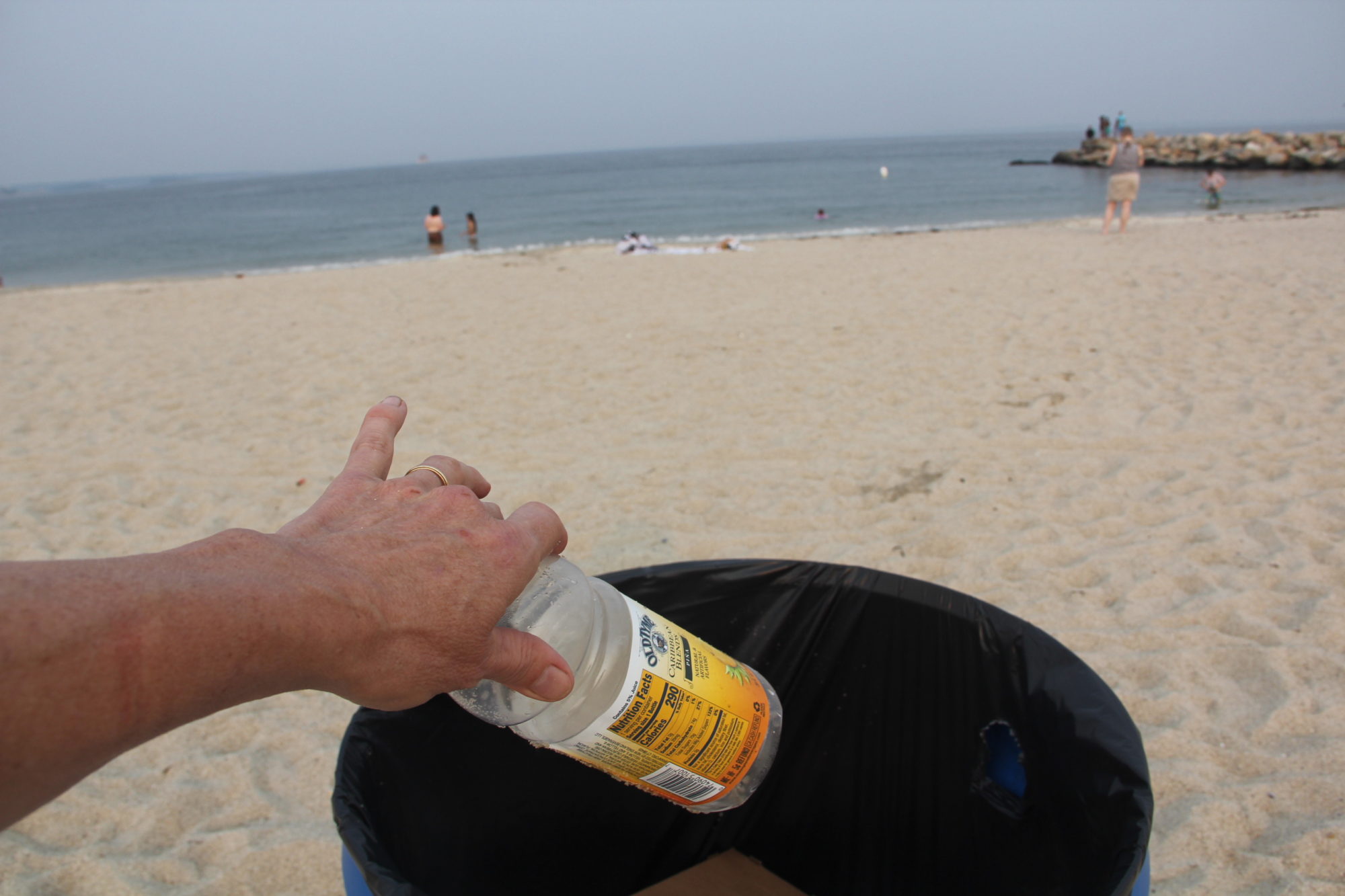
Contact: Judy Benson, CTSG Communications Coordinator, Judy.benson@uconn.edu
Groton, CT (Aug. 10, 2021) – The Connecticut Sea Grant program, joined by volunteers from Save the Sound, the Maritime Aquarium at Norwalk and other groups, will launch the fifth annual #DontTrashLISound campaign with a cleanup at Sherwood Island State Park in Westport on Aug. 16.
This year’s campaign, run by the Connecticut and New York Sea Grant programs with support from the Long Island Sound Study, will run through International Coastal Cleanup Day on Sept. 18. It will consist of cleanup events in both states, social media posts and giveaways of “Protect Our Wildlife” stickers for reusable water bottles and travel mugs.
The theme of this year’s campaign, #DoOneThing, encourages people to take at least one action to reduce litter on streets, parks and beaches before it gets carried into waterways and ultimately Long Island Sound. Social media posts will emphasize positive steps people are taking to address the problem.
“Campaigns like this one help keep people aware of the larger marine debris problem affecting Long Island Sound,” said Nancy Balcom, associate director of Connecticut Sea Grant. “They also help people focus on doable actions that we can all undertake with as much or as little effort as we have time to commit.”
A mid-campaign beach cleanup will be held on Aug. 30 at Hallock State Park Preserve in Riverhead NY, hosted by New York Sea Grant and the Atlantic Marine Conservation Society. Interested volunteers are encouraged to reach out to NY Sea Grant LISS Outreach Coordinator Jimena Perez-Viscasillas at jbp255@cornell.edu.
For information on upcoming cleanup events, visit https://www.savethesound.org/2021cleanup/ for Connecticut and http://www.nysbeachcleanup.org/ for New York.
For information on the #DontTrashLISound campaign and how to obtain “Protect Our Wildlife” stickers, CT Sea Grant Communications Coordinator Judy Benson at judy.benson@uconn.edu in CT, or NY Sea Grant LISS Outreach Coordinator Jimena Perez-Viscasillas at jbp255@cornell.edu in NY.
Every fall, volunteers from all over the world, including Long Island Sound, conduct coastal cleanups and report their findings to the Ocean Conservancy as part of the International Coastal Cleanup. Here is what was collected in Long Island Sound cleanups in fall 2020.
The coastal cleanups in the Long Island Sound region are coordinated by the American Littoral Society in New York and Save the Sound in Connecticut. The Long Island Sound Study compiles the data for the Marine Debris Ecosystem Target.
